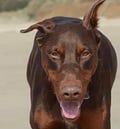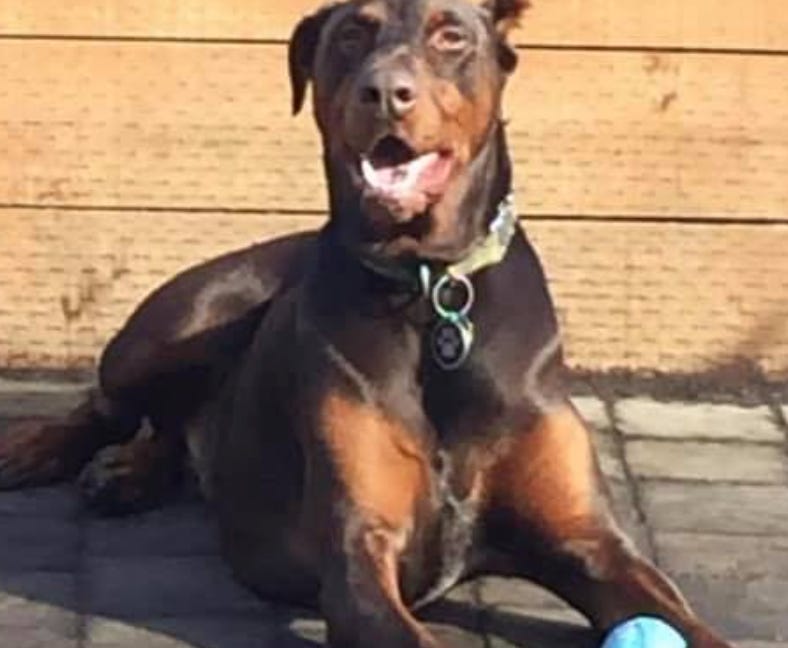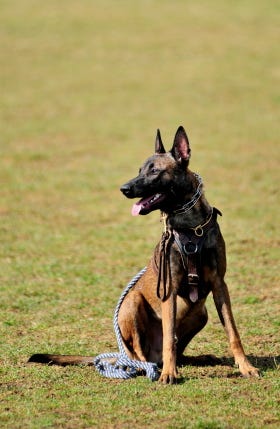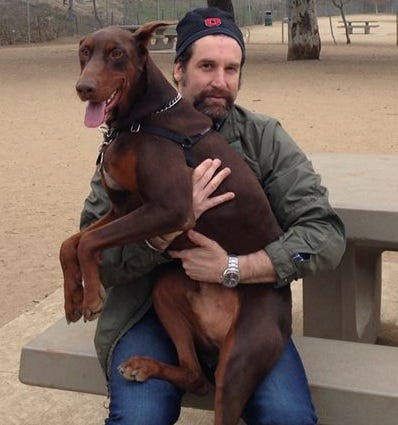Blue Collar Working Dogs to the Rescue!
An Interview With Barry Hewitt Of Blue Collar Working Dog
By Jordan Schaul | National Geographic | February 5, 2014
I recently rescued a young male Doberman from a Doberman rescue in Southern California. Although I was seeking a companion pet, I dedicated some time to learn more about this breed in terms of the purpose it was intended to serve as a working dog. In recent years, our society has embraced the “mutt” due...February 5, 2014
I recently rescued a young male Doberman from a Doberman rescue in Southern California. Although I was seeking a companion pet, I dedicated some time to learn more about this breed in terms of the purpose it was intended to serve as a working dog.
In recent years, our society has embraced the “mutt” due to the need for so many mixed breed dogs in need of lifelong care.
There is still, however, a place for the “purebred” dog particularly among the modern working breeds, which were carefully developed to serve in an array of capacities from protection, and herding, to tracking and detection.
The Doberman, which originates from Germany, was developed as a working breed and eventually by the late 20th Century was used specifically to provide protective services to owners and clients. Most Dobermans are now commonly purchased or adopted as pets and many are bred to be show dogs. Some are trained for protection by both the private and public sectors, which include those trained to work with law enforcement agencies and the military.
Since the tragic events at last year’s Boston Marathon, security has been heightened at public events nationwide and with this increase in security more trained dogs have been recruited to help protect the public.
I reached out to working-dog trainer Barry Hewitt. Barry owns Blue Collar Working Dog in Los Angeles, which sells dog training accessories to trainers and handlers of protection dogs and dogs, which provide other services. To my knowledge, it is the only store of its kind on the planet.
Interview:
Jordan: I walked into your store and was amazed at the accessories available in the commercial market for the training of protection dogs. Is there a growing demand for protection dog services?
Barry: Yes, There seems to be a growing fear with our societal issues. People are feeling the need to protect themselves, and their property. Also, I hear a lot of people saying that they wouldn’t want to own a gun. The odds of hurting yourself with your own gun are higher than the odds of getting hurt by an assailant. The next best thing to owning a gun would be a protection dog. Walking down the street with a dog on your side is less menacing to the public, than walking with a gun strapped to your side. Protection dogs are very popular with families that have kids. Parents feel that they could leave their child out playing in the front yard all alone with a dog and not have to worry someone may come by and kidnap them.
Jordan: What are some of the most popular or preferred protection dog breeds and how are they sourced?
Barry: The German Shepherd is still the most popular protection dog breed. Especially with families. They’re stable in temperament, have a medium to high drive and they have a natural herding instinct. This calmer and more stable disposition makes them better as a family protection dog than the other more “militant” working dogs such as the Belgian Malinois or Dutch Shepherd. However, we are seeing the German Shepherd used less and less by professional handlers. The Belgian Shepherd (Malinois) is becoming extremely popular (especially after the Bin Ladan capture) with the military, police, border patrol, search and rescue, and for use in personal protection. These extremely athletic and high drive dogs are “the go-to dog” for professional handlers. They also are a bit smaller than the German Shepherd (you can throw them over your shoulder, boost them over a wall, etc.) yet they can jump higher and move faster and are much healthier due to the fact that they have not been “overbred” yet by reckless American backyard breeders. Due to their extremely high drive and sharp character, The Malinois and the Dutchie aren’t recommended for families that have kids, but there are certain breeders that are making them more “stable” and we are now starting to see them in more homes. Other popular dogs for family personal protection are the Rottweiler, and the Doberman pincher, although you will seldom see them used in military or police operations. For strictly scent-working, it is still the labrador and the bloodhound. But if you want an all-purpose dog who is athletic, protective, and can do scent detection work, the Malinois and Dutchie is the breed.
The genetics of working dogs is very important. Genetics plays an important role in temperament, personality, intelligence, and general health. Historically, the best genetics have come from Europe. Europe retains very strict breeding laws and because of this the dogs coming from countries like Germany, Slovakia, Belgium, Hungary, Holland, France, and the Czech Republic will have much better genetics. Even today most of the American police and military dogs are being imported from Europe. In the United States, anyone can breed a dog, and if you mail in some paperwork you can get some sort of AKC recognition for that dog. Due to low, or “no” standards in the US, we have totally washed out the genetic pool and created some pretty unhealthy and “unworkable” dogs. But, there are a handful of good breeders here, that really do take the time to consider what they are putting together.
Jordan: As an exotic animal trainer, I learned to train and condition large carnivores through the use of positive reinforcement techniques, which are commonly used for working with companion animals. But in the past decade, there has been a resurgence of dominance-based training as a means to interact and teach obedience to dogs. Can you talk about the kind of training techniques that most protection dogs are subjected to?
Barry: I think the resurgence of dominance-based training is coming from Cesar Milan. In my opinion, some of his techniques are good for certain situations. We have to consider that Cesar Milan is trying to “fix” existing behavioral problems, and he must do this relatively quickly. Of course, positive reinforcement is, in my opinion, the only way to go when you train a dog from the beginning. But, it can be quite laborious and time-consuming if you use it to fix deep issues. To use positive reinforcement in fixing issues one needs to create an extremely controlled environment, any and all people that interact with the dog must be on board and they all must be vigilant. This doesn’t necessarily work for most families and it certainly doesn’t work for trainers who are hoping to get paid in just a few sessions. Unfortunately, the world of working dog trainers is still very compulsion-based, but the new breed or working dog trainers (myself included) raise a working dog right from the beginning through positive reinforcement techniques. Plus, they incorporate an extremely controlled environment. Then you won’t have to “Cesar Milan” your dog later on.
But, we must keep in mind that we are working with dogs that have been bred for certain qualities and one of those qualities is “hardness”. Working dog trainers mostly believe that to handle a hard dog you had to have a hard hand. That if you do not correct a sharp and hard dog, the dog will one day run you over. To a certain extent, this is true. But the new progressive trainers, are proving that positive-based training makes the dog WANT to work harder and with more gusto. We use a dog’s natural curiosity and “seeking” behavior as a reward and we get excellent results. We now USE that hardness and drive to our advantage with reinforcement methods. But again, this can best be done from the puppy stage and within a controlled environment. Old school compulsion-based trainers will get a dog they have to kennel up at the end of a shift. With positive training, you get an overall more balanced, confident dog who is willing to work. I’m a staunch supporter of positive training in working dogs.
Jordan: What are some of the needs of your client base with regard to dog training and who are your clients, generally speaking?
Barry: Most of the dogs I train are used in working-dog competition sports. These competition sports go by different names depending on the country: IPO, French Ring, Mondio Ring, KNPV, NVBK, PSA to name a few. They were started as a way to gauge the workability of police and military dogs in Europe. They test both the handler and the dog in obedience, bite-work, agility, scent work, and courage. Titles in these sports are used to rate certain breeds, lines, and breeders. Even American working dogs are judged and purchased due to the titles the dogs have earned in these competitions. These sports are gaining popularity. The dogs I train compete in these sports. I also train dogs for personal protection.
Jordan: Can you talk about the future of working dogs in general. Do you see them being used more so in explosive detection or protection or in other capacities?
Barry: The future of the working dog is great. I see them being used more and more in police, the military, and society as well. It seems that dogs are more utilized for scent work than they are for protection work. We still haven’t developed a machine that can outperform a dog’s nose in finding specific scents. There are explosive dogs, drug dogs, search dogs, cadaver dogs, bed bug dogs, cancer cell dogs, mold dogs, and just about every other type of scent dog. The list goes on and on. If there is a scent to be found, dogs can find it.
The use of dogs in medical support is also very popular. We all know how dogs can assist people with medical conditions such as blindness, paralysis, mobility issues, etc. But, dogs are now being also used in psychiatric support as well. They have been proven effective not only for emotional support but also for assisting people with autism, PTSD, Alzheimer’s, etc. The dog is truly “man’s best friend.” We will be continuing to find other ways for the dog to help us. Avalanche Search Dog: NGS VIDEO






